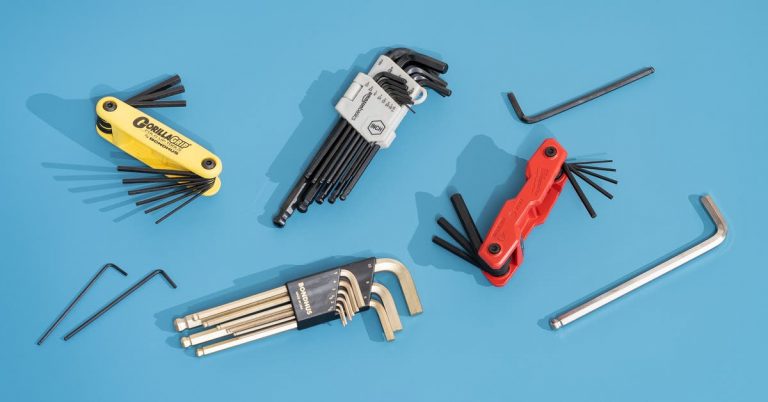How to Be Handier | Reviews by Wirecutter
CAIRA: Hey there, it’s Caira. A few days ago, we released an episode with actor, writer and woodworker Nick Offerman. It’s a really fantastic conversation… and if you haven’t listened yet, go find it.
We talked with Nick about the tools he likes, and the woodworking projects he thinks are good to start with, especially with kids. But here at Wirecutter, our tool expertise goes beyond woodworking. We have a team of home improvement writers who cover everything from power tools, to simple hand tools, to the best way to store tools.
So, in light of our episode with Nick Offerman, we thought it’d be helpful to bring you some more in-depth information on how to build a basic toolbox, whether you’re starting from scratch… or a couple steps above scratch.
Today, we’ll chat with senior staff writer Doug Mahoney. Doug has joined us on the podcast many times before to chat about everything from fire safety, to pest control. He’s also been using tools professionally and writing about them for years.
In a minute, Doug tells us what tools you really need to start being handy, what you can expect to spend, and what you don’t need to invest in as a beginner.
CAIRA: Welcome back. With us now is Doug Mahoney, who is a senior staff writer on the home improvement team who specializes in hand tools and power tools. He also covers home improvement topics, outdoor power equipment, and pest control, which y’all probably already know. And Doug owns a hobby farm in the woods of New Hampshire where he’s constantly fixing up something in his own home.
CHRISTINE: Doug, welcome back.
DOUG: Hi. How is everybody?
CAIRA: Good.
CHRISTINE: We’re great, and we’re so happy to have you back. So Doug, you are someone that I think anyone would consider a classic handyman. I hope you weren’t offended by that term, but you’ve remodeled your home, you’ve worked as a carpenter, you review tools for a living, but the level of handiness that you have achieved is beyond what most listeners would probably feel comfortable with. Tell us why you think most people listening to this should become handier in their own home.
DOUG: For one, obviously it saves you money. It’s also, it’s empowering, it shifts your relationship with your home. You start to see your home as something that you can really adapt to your needs. It’s not a static thing anymore. And you also, you don’t have to rely on other people to fix things. Say if there’s a plumbing issue with your faucet, you may have to wait a few days or a week for a plumber to show up. Whereas, if you have a little bit of know-how and confidence to do it, you can just dive right in and speed the timetable up.
CAIRA: So even if somebody doesn’t consider themselves super handy, what are the types of things anyone can do with a really basic toolkit?
DOUG: Well, first, you can start just if you’re really starting with no knowledge as far as any of this stuff, I think painting a room is a great place to start. It starts to shift how you look at your house. Obviously every house has a loose wobbly hinges or handles, things like that you can tighten. Another pretty interesting thing, you could just swap out the hardware on your kitchen cabinets, which is a very simple process, but it can really change the look of your kitchen.
CAIRA: What if somebody has zero tools in their home right now? Where should they even start?
DOUG: What I tell people is it’s almost the trifecta of tools to start with. A screwdriver is a great starting tool, a hammer, and a tape measure. Those are three pretty essential tools that you can really do a lot of little things in your house with. You can tighten hinges, you can hang pictures.
CAIRA: I have two out of three of those, I think. What about a pre-made kit? I’ve seen a lot of those at Home Depot.
DOUG: Yeah, the pre-made kits, they’re okay. They’re very, very limited. As far as I’m concerned, they cost more than what they’re worth. They usually seem to be about $40 or so. I think they’re probably worth more like 20. They are pretty poor quality tools. To me, they’re perfect for if you’re sending a kid off to college and you want them to just have something, it’s a place to potentially start. But I think that if you’re approaching this work with any seriousness, you’re going to bump up against the limitations of those tools very, very quickly. So I think that I would just recommend getting the individual tools, get yourself a nice screwdriver, a nice hammer, a nice tape measure, good utility knife, pliers, things like that.
ROSIE: Doug, if I’m standing in Home Depot in front of a wall of hand tools, it can be overwhelming to know which ones to buy. What is the difference between, for instance, a mediocre hammer or a screwdriver and really good ones? Why would you want to spend more for hand tools versus getting the cheaper thing?
DOUG: The thing with tools is that the cheapest thing usually does still work, but it’s just not going to be a very good experience. A better tool, you’re going to notice it just feels better in the hand, the grip is going to be much better, the overall design will be better. A really nice set of wirecutter’s will cut with much more power than a cheaper set. The jaws might be designed differently to give a cleaner cut. Things like screwdrivers are going to be made of much better steel so they don’t become mush and become unusable. So it’s just going to make your work a lot easier and it’s definitely more of an investment. You’ll probably be paying anywhere from 15 up to, say, $30 per tool if you’re buying the tools individually, but they’re going to turn into lifetime tools. I think it’s worth leveling up to the good stuff.
ROSIE: So once someone has the core tools, what other tools would you recommend they consider adding over time? So if you’re doing this ad hoc, what are you adding to your collection as you move forward?
DOUG: Once you have those basics, I would then move on to the plier wrench category. So adjustable pliers, adjustable wrencha, those are great for adjusting bike seats and tightening faucet, obviously they’re very good plumbing tools. Then you have locking pliers, which are vice grips. Stud finder, that’s a pretty basic one, especially if you’re hanging a heavy mirror on the wall, things like that.
ROSIE: Okay, so level, stud finder could be potentially helpful. What else?
DOUG: Allen wrenches are good. They’re another one used, especially if you have kids who have bikes. It seems like half the adjustments on bikes are with Allen wrenches. I think a headlamp is really good, especially if you have a basement. If you have a nasty crawl space like I do, headlamps are pretty helpful to be able to work and still get some light on what you’re doing. And then if you could get into any electrical work or you start figuring out your electrical system in your house, a non-contact voltage tester is a good one. And what you do is you can place the tip of it against a wire and it will tell you if that wire is live. You can also stick them into an outlet to see if an outlet is live. So it’s a good troubleshooting thing like, okay, my lamp doesn’t work, I’ve changed the bulb. And then you can take a non-contact voltage tester and you can test the outlet to see if the outlet’s working.
CHRISTINE: This sounds both incredibly handy and advanced. I think I’d be scared to be like, oh, here’s a wire. Let me just see if it’s working.
CAIRA: Stick this thing in a live outlet maybe.
DOUG: Well, it’s a non-contact thing, so you can do it. You don’t even need to touch the wire. You just get the tip of it close to the wire.
CHRISTINE: When do you think it’s worth graduating from hand tools into power tools? Things like an electric drill or a power sander or a saw?
DOUG: Well, getting into those tools, that’s when you really start taking on a proactive approach. You’re not really just reacting to the loose handle or the jiggly towel bar. That’s when you’re like, I’m going to fix this rotted deck board, I want to maybe put in a screen door, things like that. So it depends on where you’re at, what projects you have. If you’re a renter, you may not need to, although I think a cordless drill is probably essential for anybody who’s interested in taking on this kind of work. From there, you can graduate up into saws, circular saw, jigsaw. You can get pretty much everything you need done with those two tools as far as cutting goes, and then an orbital sander after that. That would be the first basic kit, I think, of power tools to get.
CHRISTINE: So you said earlier most people should have a power drill. What does that unlock? What can you do that you couldn’t do if you don’t have one?
DOUG: Well, first it can save a lot of time even from what a screw driving task is. If you’re putting in a door hinge instead of sitting there screw, screw, screw, screw, screw, you can get it done in less than a second and you’re not really relying on hand strength. You’re not exhausting your hand. And secondly, you can start really putting things together. You can drill holes, you can drive screws, so you can start to replace the deck board. You could, as far as drilling holes, anything from a birdhouse opening to drilling the holes you need to put in a curtain rod or a knife rack. It really opens up a huge, huge arena of things you can do.
CHRISTINE: What is our top pick?
DOUG: Our top pick is a little 12 volt DeWalt.
CHRISTINE: And how much does it cost?
DOUG: The 12 volt drills usually go, that’s actually the smallest class of cordless drill. They usually go for less than 150. They’re often on sale to about 100, which comes with a drill, two batteries, and the charger.
CHRISTINE: And at this point, we only recommend cordless drills, right? We don’t really have any corded drills that we recommend.
DOUG: No, no, definitely not. Corded tools are definitely on their way to becoming extinct at this point. Battery technology has gotten just phenomenal so there’s really no point in having a corded drill.
CAIRA: Let’s say that you buy a really nice power drill and you’re feeling emboldened. Do you just jump right in and buy every power tool there is at once? Or the dreaded question, do you buy a kit?
DOUG: Well, in the case of power tools, a kit is a great place to start, unlike what we were just saying with hand tools. For one, it’s a way to get a lot of tools at a fairly low price. So the way to think about power tools is that, and this is certainly the way manufacturers think about it, is that you’re buying their batteries, you’re buying into their battery system. So they want you to buy their tools because then you’re going to be more likely to buy other of their tools, which are compatible with the same battery. Which also makes sense from the consumer point of view, too, because once you have a couple Dewalt batteries, you can also buy another Dewalt tool as a bare tool, which means it comes at a reduced price and it doesn’t have a battery or it doesn’t have a charger.
So the kits are great. You can get a wide variety of tools. Often they come with a drill, a circular saw, maybe reciprocating saw, oscillating multi-tool, which is a phenomenally useful tool, maybe a flashlight, and then you get two batteries and a charger. And sometimes that’s for as little as $200, which is just a fantastic price. It’s a good place to get started. You get a little bit of everything, so you have everything you may need.
CHRISTINE: And in oscillating multi-tool, I have never heard of that before. What is it? What does it do?
DOUG: Yeah, so oscillating multi-tools, pretty interesting. For a long time, one company had the patent on this tool. It’s a company called Fein, it’s a German company, but what it does is you can put a lot of things on it. You can put a blade on it, you can put a sander on it, but what it does is it oscillates back and forth slightly. So there’s a lot of benefits to that. If you put a sanding pad on it, there’s a triangular sanding pad, so you can get it right into an inside corner. If you have a saw blade on it, and these saw blades, they’re only like an inch wide, you can plunge cut directly straight into a wall, so it’s not like a circular saw, which is going to make a huge mess. So if you’re cutting in for an outlet or something like that, you could just plunge in and then just make a really tight, nice little box. There’s also little heads on it, little grinder heads, so you can clean out grout with them, too.
So Fein had it for a long time, and then, I don’t know, 10 years ago or so, their patent wore out, and so then there’s been a flood of other companies. So now everybody pretty much has one. They’re really good. They’re definitely like a renovator’s tool for sure.
ROSIE: Doug, do you have any final pieces of philosophical advice for people who are interested in becoming handy?
DOUG: You’ve got to seriously think about safety with these tools, especially saws. Just try not to get in over your head. It’s probably going to happen at some point, and YouTube is a great resource, but make sure if you have a project in mind, you’re replacing your toilet, for instance, watch 10 videos on people replacing their toilets and not just one. And that way you can get a sense of what the truth is of the process, what kind of things everybody deals with, what kind of things you might run into. If you have an old house, good luck to you because everything goes sideways very quickly on an old house. I know. My house is 250 years old and nothing is to any standard, but keep a good attitude about it and my brother-in-law always says this. he says, “Don’t let perfect get in the way of pretty good.”
ROSIE: Well, thanks Doug. Always love having you here. It’s the best. Thanks for joining us.
CHRISTINE: Thank you.
CAIRA: Thanks, Doug.
DOUG: Fun to be here.
CAIRA: We will drop links in our show notes to Wirecutter’s top picks for hammers, screwdrivers, drills, and other tools. And we’ll also link to some safety equipment, like eye protection and dust masks, that you should use when you start getting handy.
That’s it for us. We’ll be back next week with a brand new episode. Thanks for listening.






